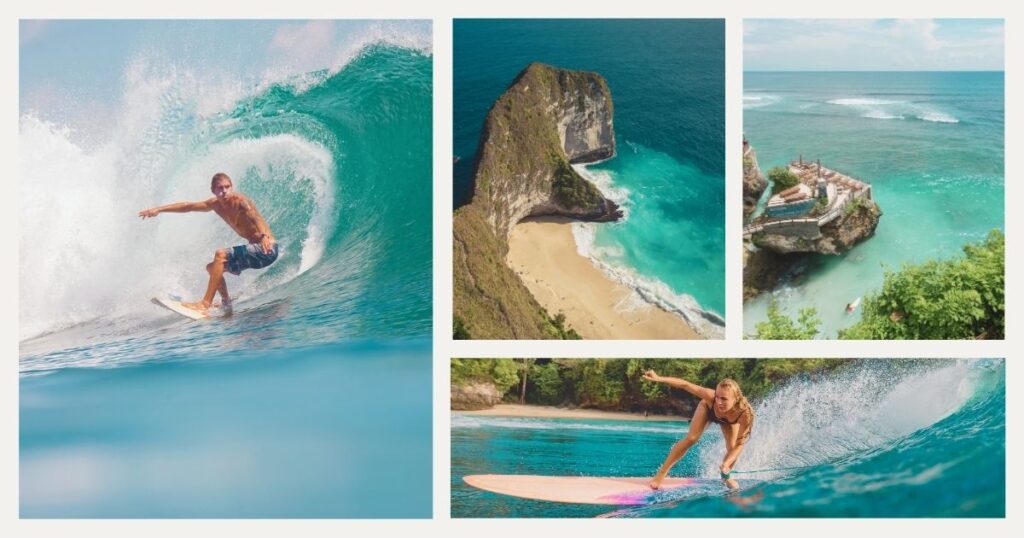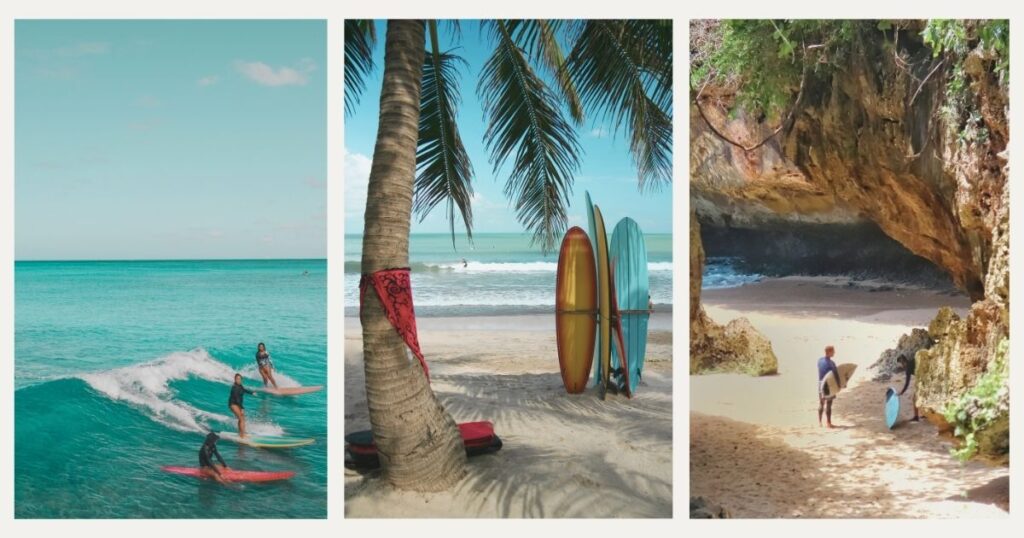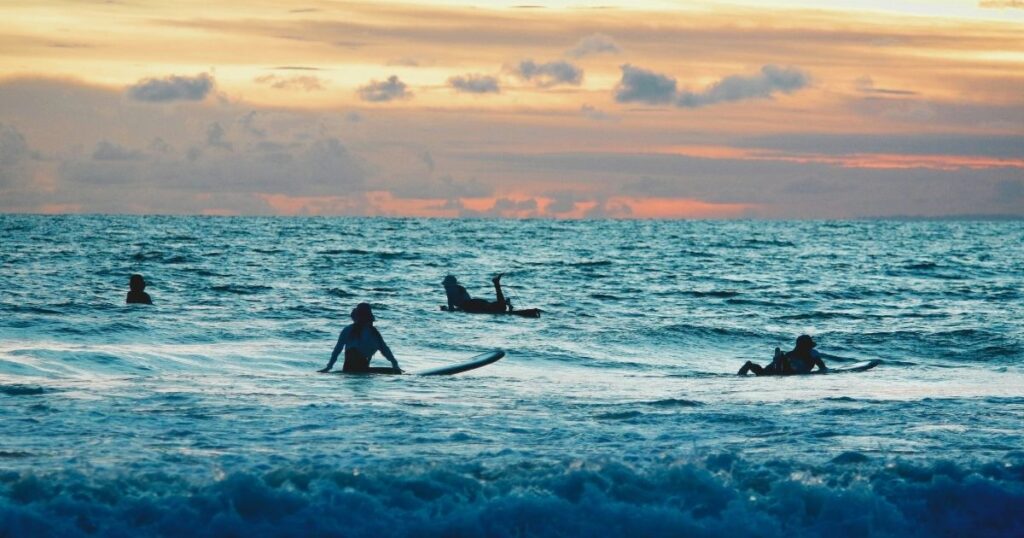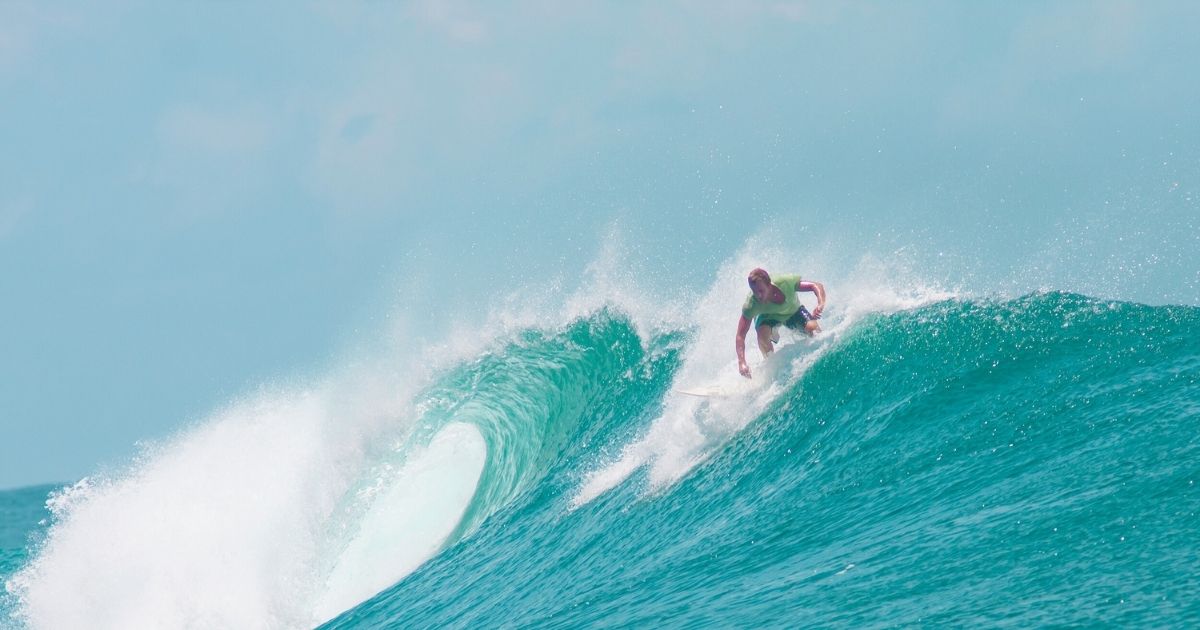Picture yourself paddling out at dawn, the tropical breeze carrying the scent of frangipani as you watch the sun rise over volcanic peaks while perfect waves roll toward pristine beaches. For digital nomads who crave the perfect balance between productive work sessions and exhilarating surf adventures, Bali offers an unmatched combination of world-class waves and remote work infrastructure.
Bali surf culture represents far more than just catching waves—it embodies a lifestyle that seamlessly blends professional flexibility with passionate pursuit of the ocean’s rhythm. From gentle beginner breaks to challenging reef breaks that test experienced surfers, the island’s diverse coastline provides surfing opportunities for every skill level.
This comprehensive guide explores Bali’s premier surf destinations, offering insider knowledge about wave conditions, seasonal patterns, and practical considerations for nomads who want to integrate surfing into their Indonesian adventure.
Understanding Bali’s surf seasons and conditions

Bali’s unique geographical position creates distinct surf seasons that influence wave quality and crowd levels. Understanding these patterns helps digital nomads plan their stays effectively.
The dry season from April to October delivers consistent Bali surf conditions, with offshore winds creating clean waves along western and southwestern coastlines. Breaks like Uluwatu, Padang Padang, and Bingin produce their most reliable waves during this period.
The wet season from November to March shifts focus to eastern coastlines, where protected breaks like Sanur offer more sheltered conditions. Reduced crowds and lush scenery create a more intimate surfing experience.
💡 Did you know? Bali’s surf breaks are heavily influenced by Indian Ocean swells that travel thousands of miles before reaching the island. The most powerful swells typically arrive during the dry season, creating waves that can exceed 15 feet at premier breaks like Uluwatu and Impossibles.
Wave types and break classifications
Bali surf spots feature diverse wave types for different surfing styles. Reef breaks dominate the southern peninsula, offering powerful waves that break over coral formations. These provide exceptional quality but demand experience.
Beach breaks along eastern and northern coasts offer gentler waves over sandy bottoms, ideal for beginners. Popular destinations include Kuta, Legian, and Seminyak.
Point breaks create long rides as waves wrap around headlands. Uluwatu exemplifies this type, providing rides extending several hundred meters when conditions align.
Beginner-friendly Bali surf spots
New surfers and those developing their ocean skills will find numerous welcoming breaks that provide safe learning environments while still delivering genuine surfing excitement.
Kuta Beach
Kuta Beach stands as Bali’s most accessible surf destination, offering consistent small waves over sandy bottoms. The beach’s proximity to the airport and abundant surf schools make it ideal for beginners.
Waves typically range from 2-4 feet with gentle breaks that provide time for practicing pop-ups and positioning. The sandy bottom eliminates coral concerns, allowing focus on skill development.
Multiple surf schools offer equipment rental and instruction. The area includes cafes, accommodation, and amenities supporting extended surf stays.
🌟 Pro tip: visit Kuta Beach during early morning sessions (6-8 AM) to enjoy the best wave conditions and avoid afternoon onshore winds that can make waves choppy and less suitable for learning. The dawn patrol also provides stunning sunrise photography opportunities.
Batu Bolong Beach (Canggu)
Batu Bolong represents Canggu’s most popular beginner to intermediate spot, with consistent waves over sand and reef. The break offers more challenge than Kuta while remaining accessible.
Waves typically produce 3-6 foot breaks, providing opportunities for longer rides and advanced maneuvers. The partially sandy bottom offers forgiveness for wipeouts.
Canggu’s digital nomad community makes Batu Bolong appealing for remote workers, with coworking spaces, reliable wifi cafes, and nomad-focused accommodations.
Intermediate Bali surf destinations

Intermediate surfers seeking more challenging waves and varied conditions will find numerous breaks that test growing skills while providing progression opportunities.
Echo Beach (Canggu)
Echo Beach delivers more powerful waves than neighboring Batu Bolong, attracting intermediate to advanced surfers. The break produces waves reaching 8-10 feet during larger swells.
Breaking over reef and sand, the wave creates fast sections demanding quick reflexes and solid fundamentals. Multiple takeoff zones allow surfers to choose positions based on skill level.
The dramatic black sand coastline creates one of Bali’s most photogenic surf settings, ideal for content creation.
Balangan Beach
Balangan offers an intermediate stepping stone toward challenging Bukit Peninsula breaks. This right-hand point break produces long waves over the reef and sand, excellent for skill development.
Waves typically range from 4-8 feet with consistent surf during the dry season. The forgiving nature allows intermediate surfers to attempt advanced maneuvers while building confidence.
The pristine white sand beach and turquoise waters create a tropical paradise setting with basic amenities for day-long sessions.
Advanced Bali surf breaks
Experienced surfers seeking world-class waves and serious challenges will find breaks that rank among the planet’s finest, offering powerful, hollow waves that demand respect and skill.
Uluwatu
Uluwatu stands as Bali surf’s crown jewel, with multiple sections producing Indonesia’s most perfect waves. This left-hand reef break offers mellow inside sections for intermediates to charging outside peaks for professionals.
Various sections—Temple, Outside Corner, Racetrack, and The Bombie—provide options for different skill levels and conditions. During optimal conditions, waves connect across sections for 200-meter rides.
Access requires navigating steep paths and understanding tidal influences. The break demands reef break experience due to shallow coral and strong currents.
🌟 Pro tip: study Uluwatu’s tide charts carefully and plan sessions around mid to high tide periods when the reef provides adequate water depth. Low tide periods can create dangerous shallow sections that even experienced surfers avoid.
Padang Padang
Padang Padang delivers intense, barreling waves over extremely shallow reef, creating one of Bali’s most challenging experiences. This world-famous break gained recognition through surf films and professional competitions.
The wave produces perfect barrels, demanding precise positioning and commitment. Wave sizes range from 4-12 feet, with larger swells creating intimidating conditions for experts only.
Access involves threading through narrow cave passages during certain tides, adding adventure to the experience. The break attracts surf photographers, making it ideal for documenting achievements.
Digital nomad-specific surf considerations
Balancing professional responsibilities with passionate surf pursuits requires strategic planning, reliable infrastructure, and flexible scheduling that accommodates both work deadlines and optimal wave conditions.
Connectivity and remote work integration
Modern surf destinations in Bali cater to digital nomads with reliable internet and workspace options. Many surf camps offer dedicated coworking areas with high-speed internet for nomadic needs.
🌟 Pro tip: invest in reliable mobile connectivity through Holafly’s international coverage to ensure seamless communication during surf trips and work sessions. Their plans provide consistent access, whether checking waves at dawn or handling client calls.
Successful integration involves scheduling flexibility to capitalize on optimal wave conditions while maintaining work commitments. Many nomads adopt early morning surf sessions followed by afternoon work periods.
Time zone advantages allow European and American nomads to surf during Bali’s prime morning sessions while maintaining communication windows with clients.
Equipment and logistics
Surfboard rental throughout Bali eliminates expensive international transport while providing equipment designed for local conditions. Most areas offer daily and weekly rates accommodating varying stays.
Local shops provide repair services, wax, and accessories essential for maintaining equipment. Many offer board storage for nomads purchasing equipment without permanent accommodation.
Transportation requires consideration when planning surf missions from nomad hubs. Motorbike rental provides flexible, cost-effective transportation to various breaks.
Surf culture and community in Bali

Bali’s surf community welcomes international visitors while maintaining respect for local customs and environmental stewardship. Understanding cultural nuances enhances your experience while contributing positively to communities.
Respecting local surfers and customs forms the foundation of positive experiences. Understanding lineup etiquette and appropriate behavior demonstrates cultural sensitivity while ensuring harmonious interactions.
Surf breaks maintain informal hierarchies based on local knowledge and skill level. Visitors showing respect, patience, and willingness to learn often receive warm welcomes and insider knowledge.
Environmental consciousness plays an important role in Bali surf culture, with growing awareness of pollution and reef protection. Participating in cleanups and supporting eco-friendly businesses helps preserve what makes Bali surf options special.
💡 Did you know? Many of Bali’s premier surf breaks are located near sacred Hindu temples, and local customs request respectful behavior and appropriate dress when traveling to and from these areas. Showing cultural sensitivity enhances your welcome in local surf communities.
Seasonal planning and wave forecasting
Maximizing your Bali surf experience requires understanding seasonal patterns and optimal timing strategies that align wave quality with travel schedules.
Beginner surfers benefit from visiting during the wet season (November-March) when the eastern coast breaks offer gentler conditions with fewer crowds, providing ideal learning environments.
Intermediate surfers find optimal conditions during shoulder seasons (April-May and September-October) when waves remain manageable while providing challenging development opportunities with better accommodation value.
Advanced surfers target the dry season (June-August) when the southern peninsula breaks receive consistent, powerful swells delivering the epic conditions that make Bali famous globally.
Flexible planning allows nomads to capitalize on unexpected swell events. Modern forecasting provides 7-10 day advance notice of significant swells, enabling strategic planning for epic sessions.
Final thoughts
Discovering where to surf in Bali opens doors to incredible wave-riding experiences that perfectly complement the digital nomad lifestyle. The island’s diverse breaks, from beginner-friendly beach breaks to world-class reef breaks, provide surfing opportunities that grow with your skills while offering endless exploration possibilities.
Success in balancing Bali surf adventures with remote work responsibilities lies in understanding seasonal patterns, respecting local customs, and maintaining flexibility that allows you to capitalize on both optimal wave conditions and professional opportunities. With proper planning and cultural sensitivity, surfing becomes an integral part of your Indonesian experience rather than a distraction from work commitments.
Ready to dive into Bali’s incredible surf scene? From perfect beginner breaks to world-class reef breaks, the island offers waves that will challenge and inspire surfers of every level. For comprehensive guidance on making the most of your Indonesian adventure, explore our detailed digital nomad visa guide for Indonesia to ensure you’re properly prepared for extended surf-focused stays.
Let Nomada help you create the perfect balance between catching waves and remote work success 🏄♂️
Frequently asked questions about surf in Bali
The dry season from April to October offers the most consistent surf conditions for intermediate to advanced surfers, with offshore winds and regular swells hitting the southern peninsula breaks. Beginners may prefer the wet season (November-March) when eastern coast breaks provide gentler, less crowded conditions.
Surfboard rental is widely available throughout Bali’s surf areas, with daily rates ranging from $10-20, depending on board type and location. Many nomads find renting more practical than international shipping, especially for shorter stays or those wanting to try different board types for local conditions.
Yes, breaks like Kuta Beach and parts of Canggu offer ideal beginner conditions with sandy bottoms, gentle waves, and numerous surf schools. These areas provide safe learning environments while still delivering authentic surfing experiences that help build confidence and skills.
Advanced breaks like Uluwatu and Padang Padang feature shallow coral reefs, strong currents, and powerful waves that can cause serious injuries. These breaks require significant surfing experience, local knowledge, and respect for ocean conditions. Always surf with others and consider local guide services for initial sessions.
Daily surfboard rental costs $10-20, surf lessons range from $25-50, and transportation to breaks typically costs $5-15 per trip. Monthly surf budgets for active surfers often range from $200-400, including equipment, transportation, and occasional guided sessions or coaching.
Canggu hosts the largest concentration of surf-focused digital nomads, with numerous coworking spaces, accommodation options, and social groups specifically catering to remote workers who surf. Other areas like Uluwatu and Bingin also have growing nomad communities centered around surfing lifestyles.



